photos by Liam Doran
The Antarctic Peninsula is home to the unlikely. From a place where Shackleton and his men simply hoped to survive 100-plus years ago to the frozen home of a geopolitical turf war during and after WWII, to being a ski touring hub off a luxury cruise ship today, the peninsula seems utterly unchanged and miraculously unmarred by human activity. And what made Shackleton an unlikely hero in August 1916 is somehow inherited, at least a little, by anyone willing to risk being here. Because one thing remains true about this place: It can kill you quickly no matter how much courage you bring. But if you have money or desire—or both—one man can show you the enigma that is the White Continent.
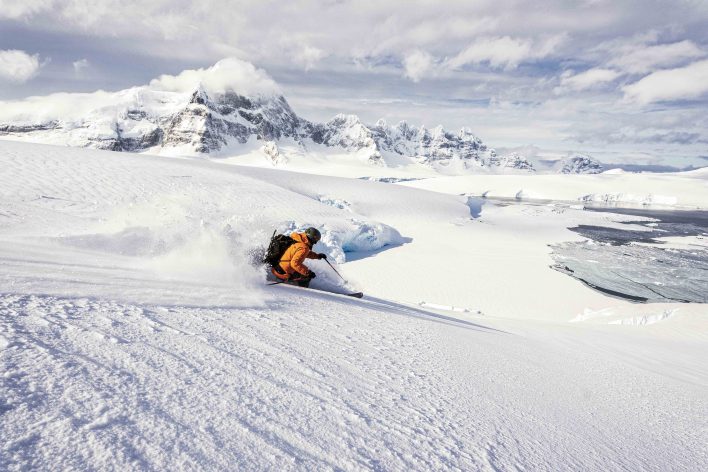
The Land of Firsts
The Antarctica of Sir Ernest Henry Shackleton is not here. Not exactly. His lies on the other side of the peninsula in the Weddell Sea, where swirling fast ice became sea ice became pack ice in 1914, suffocating the mighty Endurance until it sank off the Filcher Ice Shelf to be found only two years ago in 2022.
What we find here, today, is more life and color, which could be simply because I’m on a steel-hulled ship, part ice breaker, part luxury liner floating on the Palmer Archipelago. The musty library conjuring of the Antartica from my youth fueled by Wally Herbert’s book, Polar Deserts, about Shackleton’s escape from this place and the harrowing exploits of other polar explorers from that great generation was mostly in black and white.
The last place Shackleton would see of what, to him, must have been a continent of ghosts was Elephant Island, which is pretty much the farthest point north among the hundreds of little and large islands to the west and north of the Antarctic Peninsula. It was then for he and his crew as it is now for Doug Stoup and his ship full of guides and skiers. It is also the exact opposite direction from the South Pole to which Robert Falcon Scott and Roald Amundsen raced, in 1911, 2,000 miles away across miles and miles of horizontal and vertical ice, millions of years old.
No, this is the Antarctica of 9,000-foot mountains and powder snow, seals and penguins, Zodiac landings and white linen tablecloths, and ocean water that’s below freezing. There is fast ice here, of course, and it’s swirling in the light breeze as we prepare to disembark from the Ocean Albatross, our purpose-built, 350-foot-long polar cruise ship that is normally filled with the sightseeing set.
Pack ice, or sea ice, is remarkably quick-forming and unpredictable, as Shackleton’s crew learned the hard way when the Endurance fell into its grip and sank after being trapped at 77 degrees south. For us, the churning ice is more of a novelty—we hope—as it was yesterday during an atypically heavy snow event combined with an all-too-typical driving, westerly wind.
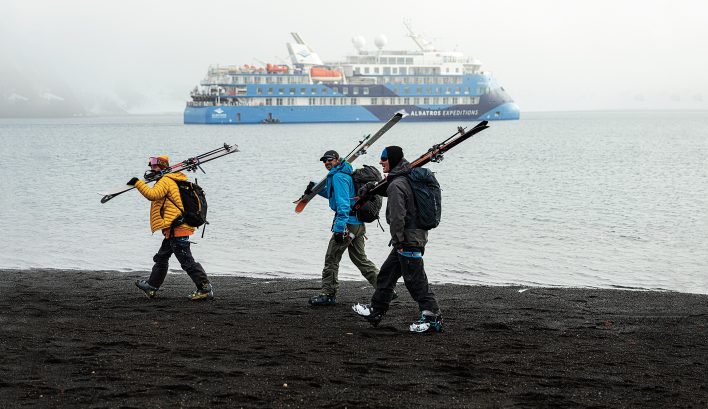
The Ocean Albatross is one of perhaps 30 or 40 specialized cruise ships that spend the summer season in the Arctic and the winter season down here. Beyond the hotel staff and crew is an “expedition team” made up of naturalists who double as pretty badass Zodiac drivers. Onboard, and during their many presentations about the flora and fauna of Antarctica, they talk about how sea ice forms. Something about the South Sea water being so cold in October—early in the tourist season—that with a little snow and a lot of wind the frothy brine expands as if it were multiplying in real time. Then it locks up around your boat, crushes it, and you die. Or, like Shackleton, you get the hell onto your life raft and head to Elephant Island, leave your crew, sail on for 800 miles, cross over South Georgia glaciers for days then commission four different boats to get back here and save every one of your crew two years later. Or, you could have a boat like the Ocean Albatross, whose constant, automated, GPS-controlled motion pushes the sea ice away like a snowplow, so we don’t get stuck here in the Neumayer Channel just off Wiencke Island, where we’ll ski today before having a nice tomato bisque soup with fresh bread and, perhaps, a bottle of malbec.
All respect to Herbert, whose book was on the free table when I collected it in sixth grade: This is not a polar desert. Not here on the Peninsula. Yes, it’s part of the driest continent on Earth, but from being accompanied by killer and humpback whales on the Drake Passage five days ago to walking with chinstrap penguins on the warm, black volcanic sands of Deception Island on our first afternoon, we’re constantly on the lookout for, for what? Things we’ve never seen and may never again, like the abandoned whale oil refinery on Deception, which became one of two British bases 80 years ago in 1944. Things fewer people will see than have been to base camp on Mount Everest. Runs fewer people will ski than have summited the world’s highest peak.
Antarctica averages less than 10 inches of snow on the Ross Ice Shelf where Scott and Amundsen started their polar ambitions with mixed results. And 20-plus inches here on the peninsula. It is a desert. But all we see is black water and blue glaciers and white snow, a snow globe of our wildest skiing dreams. By all accounts from the veteran mountain guides onboard the Ocean Albatross, yesterday’s weather was an anomaly: 2 feet of relatively wet snow fell throughout the day and through the night, followed by crystal blue skies and a light easterly breeze. We’re at the southernmost edge of the Palmer Archipelago, a string of islands that parallel the peninsula from the South Shetland Islands to Deception and on down here to Wiencke Island a few miles west of the mainland, about 64 degrees south. Not quite to the Antarctic Circle, but Antarctic enough for the Ocean Albatross’s 120 guests and 30 guides.
Tracks of Others
Along with those guides (and it’s a who’s who of guiding’s global elite), Stoup was up at 5:30 a.m. This is his boat. Or, rather, the boat his company, Ice Axe Expeditions, contracted to bring us to this mythical place. And these are his guides, many of whom, like lead guide Andrew McLean, have done this trip nearly every year since 2008. As is the case each day, a small cadre of these veteran guides clamber through the ship’s “mud room” and board Zodiacs driven by our onboard naturalists to scout and dig out each day’s landing zones.

With 150 people to get ashore, Stoup usually likes to spread the ski touring parties out over three to four landings. Today there will be only two landing zones, one of which is ours at Wiencke Island’s Damoy Point a few minutes commute from our anchorage in Dorian Bay. We’re at the south end of the Neumayer Channel, just east of Anvers Island, home to Mount Français (9,055 feet), the highest mountain on the peninsula. Stoup and McLean attempted to ski it in 2002 on his third trip to the peninsula but were thwarted by rain and fog. That failure, if you want to call it that, might have done more to motivate Stoup’s polar ambitions than his successful snowboard descents on Mount Vinson (16,050 feet) in 1999.
“After [that] trip, I called this Russian research friend of mine, and he was heading down to the peninsula, and I asked him if we could come aboard,” Stoup told me in Ushuaia, Argentina, before we went aboard. “I had a small team, and we went to the Antarctic Peninsula to pioneer skiing down there.”
One of those early zones was right here at Wiencke Island. Compared to yesterday’s landing, which featured pack ice, nuking snow, zero visibility and a 100-meter, 40-degree ramp exposed to water on both sides, today’s drop will be easy. We just have to mind the penguins. But there’s little evidence we’ll see more than a few, as the main population of gentoo penguins has yet to arrive for mating season from their winter home on the Argentinian coast. Unlike many species of penguins like the chinstrap and emperor, which are reluctant to leave their generational rookeries, scientists believe the gentoo population is thriving. They’re willing to abandon traditional rookeries and establish new ones further south as polar temperatures increase and krill populations migrate to colder waters.
By all accounts, and I mean all accounts, no one on this expedition has skied 2-plus feet of snow of this quality in Antarctica. With the exception, maybe, of Stoup, McLean and another early ski explorer of the peninsula, Chris Davenport. After landing on a nearly abandoned gentoo penguin rookery, my team splits up as we head to the toe of the glacier. This was once home to an airstrip that was used to resupply the base at Port Lockroy, located on a small island a stone’s throw from here. Our rope team, including my friends Pat Gilroy and Damian Riddle and second-time Ice Axe Antarctica guide John Mletchling from Salt Lake City peels off where the glacier levels out to ski a 300-foot, 20-degree ramp back down to the water’s edge. Our second party, photographer Liam Doran, longtime pro skier Sven Brunso and Jackson, Wyoming-based guide Aaron Dahill, follow the light before 100 other ski tourists track up the place.
Our mini golf line isn’t for nothing. There’s a mantra among veteran guides on this trip that goes something like: “If you see it, ski it.” Meaning weather, visibility and snow can change in an instant in Antarctica, just like the sea ice. So, get it while you can. By the time we’re back on the glacier most of the rest of the groups have followed our track and are heading up toward 1,788-foot Jabet Peak, its conical, rocky spire rising out of the glacier, sustained ski slopes plastered to several aspects, some that drop directly to the briny seawater.
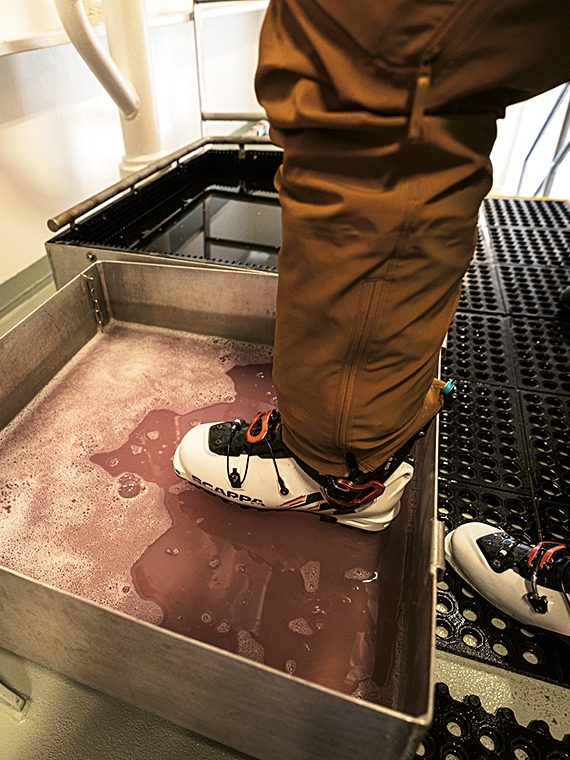
This terrain isn’t new to ski tracks. The early occupants of Port Lockroy traveled by skis to conduct research, and in 1957 the scientists and G-men started the Antarctic Ski Club complete with bylaws and annual meetings. Skiing was part of an intensive recreation program to pass time, which also included a marathon at one point. One of those founders was Alan Carroll, Port Lockroy base leader from 1954 to 1957.
“On the [western] shoulder of Jabet Peak was a pair of crossed skis, possibly left by one of Jean Charcot’s crew when the place was discovered fifty years previously,” Carroll said about his discovery in a recording made at The Language Centre of the University of Oxford (Alan Carroll, Nov 1954 – Jan 1957. Reproduced courtesy of British Antarctic Survey Archives Service. Ref. AD6/24/1/11. Copyright: UKRI-BAS.). “I’ve never seen written evidence of this but, as Charcot’s crew spent some time in Dorian Bay and they set up a mail-box on Casabianca Island, this local legend may be true.”
Knowing the bulk of the skiers today will head to Jabet’s main 30-degree, north-facing ramp, Mletchling has us traverse south and east on the glacial shelf, which drops vertically hundreds of feet to the water. As we hike and ski another mini line on the flank of Jabet, Chippie, one of the U.K. guides based in Norway, cruises below us, laying a track into the next bowl, which includes some named lines that Stoup, McLean and others have skied over the years: Alex Lowe Couloir and Sex Troll to name two.
The Enigma
Most of the other touring parties are around the escarpment sessioning Jabet’s south face, which, down here, is the shady side. “No planes flying overhead,” Damian says as we enjoy our free ride in Chippie’s track. Today planes only fly into the main part of the continent, as they aren’t allowed here thanks to the Antarctic Treaty of 1959. We traverse beneath jagged peaks and couloirs we won’t ski today and above the sheer glacial wall that drops to the sea. The Ocean Albatross idles beyond earshot and beneath the wind, moving slowly to break up sea ice.
On this trip, it’s all about keeping it mellow, or as mellow as navigating crevassed terrain allows. On Stoup’s first successful Ice Axe ski cruise to the peninsula, a client fell into a crevasse, sustaining a broken leg and necessitating an 18-hour journey by sea to get him to another ship, then an airfield on South Georgia Island and finally to a hospital in Argentina.
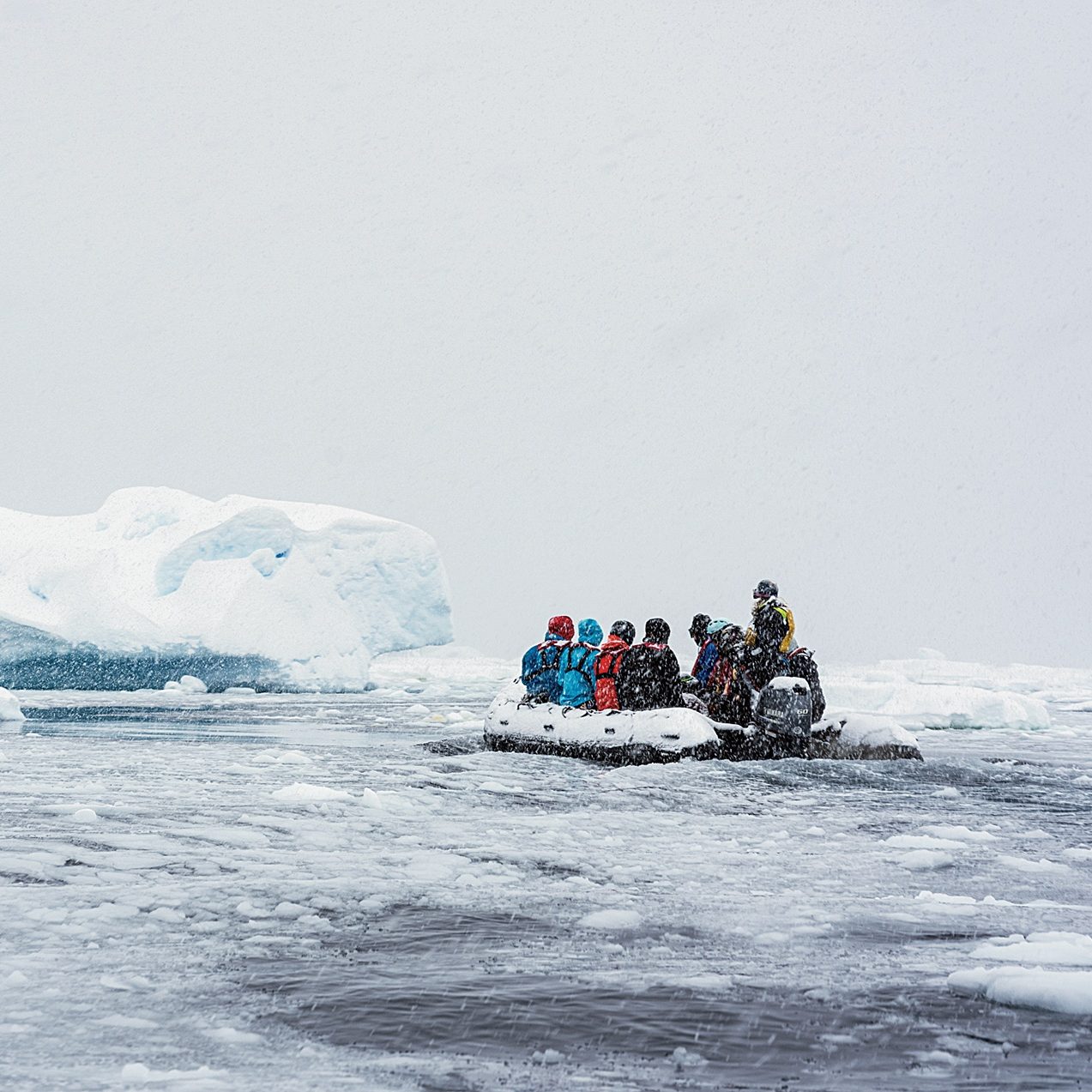
Eighty years ago, in February 1944 a secretive British mission called Operation Tabarin established the first year-round settlement on the peninsula at Port Lockroy. A hut on Wiencke Island called Bransfield house was home to 10 men. There was, at the time, considerable concern by the Admiralty that the Nazis would stake a claim to Antarctica and menace the shipping between the continent and Cape Horn. Ditto the Japanese. Given the intensity of the land war effort on the European stage at the time (D-Day was still in its final planning stages) and in the Pacific theater as well, the very existence of an outpost here underscores the seriousness with which the Allies undertook the Axis threat.
With the war winding down in 1945, Argentina and Chile had a renewed interest in their claims on Antarctica. Norway also claimed a slice known as Queen Maud Land, which covered about a sixth of the continent. It wasn’t until 1959 that a unifying agreement spelled out the future of Antarctica. Delegates from Argentina, Australia, Belgium, Chile, France, Japan, New Zealand, Norway, South Africa, the United Kingdom, United States and the Soviet Union signed the relatively simple, 14-article Antarctic Treaty in Washington, D.C., on Dec. 1, 1959. The treaty, which covers any territory south of 60 degrees latitude, stipulates the peaceful use of Antarctica and champions science. Today, we’re at about 64.5 degrees south and, literally, a stone’s throw from Lockroy and the Bransfield House. The United Kingdom Antarctic Heritage Trust has meticulously restored and maintained this site as a museum to both its mission and early residents.
By the time of the treaty, Operation Tabarin had morphed into what is now known as the British Antarctic Survey, one of the leading polar scientific organizations in the world to this day and known for its early climate research. And the little building we skied past this morning called Damoy Hut was once known as “the world’s most southerly waiting room.” It was here in the ’70s and ’80s that men would wait for the plane to land up on the skiway on the glacier.
Given the mellow ramps surrounding the toothy peaks central to this 67-square kilometer island it’s no wonder the Brits skied here a lot. And Stoup has been coming back to Wiencke year after year since 2000, nine years before he launched his first successful guided ski cruise here in 2009. His first attempt at bringing a cruise ship here in 2008 was thwarted when the ship he’d contracted didn’t pass inspection. But a lot has changed in polar tourism since then, when many of the dozen or so small cruising vessels were simply converted ice breakers or research vessels. The brand-new Ocean Albatross, on her first trip to the peninsula, is another matter. With a special hull built to take on the rough Drake Passage, and to bash ice, she’s equipped with every imaginable amenity standard on your more Mickey Mouse cruise ships.
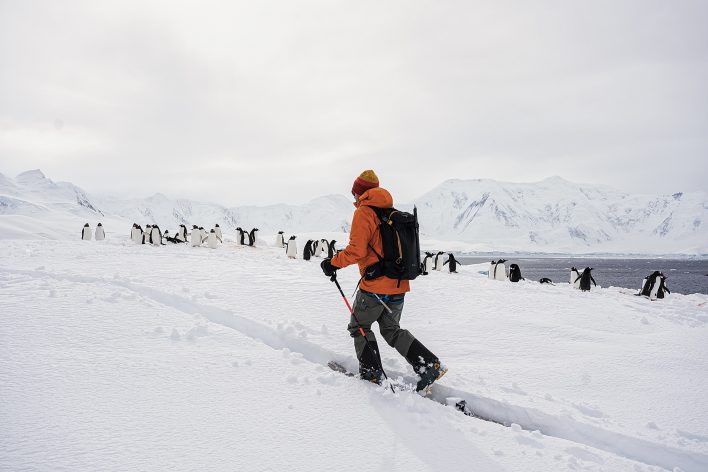
To understand why he’d be crazy enough to want to bring 100 strangers to the most logistically complicated guiding terrain in the world, you’d have to get to know Stoup a little bit. Even then, some of his longtime friends and veteran guides like McLean say good luck. “When he first said he was going to do this I couldn’t believe it,” McLean told me the day before disembarkation in Ushuaia, Argentina. “He charters the entire boat, so if he can’t fill it or if something goes wrong; I don’t know what the cost is on chartering an entire cruise ship, but it’s a huge commitment.”
“Doug is an enigma,” he added at the end of our conversation. Kind of like sea ice.
Opportunity Cost
At 60 years old, Stoup is arguably today’s foremost polar adventurer: He’s careful to point out the difference between his modern adventuring and the exploring behind all the firsts in Antarctica. “Those guys didn’t have down [insulation] or sat phones,” he’d tell me after the trip.
Stoup grew up in central Pennsylvania, the son of divorced parents. His mom was a kindergarten teacher. He saw his father on weekends. Stoup’s third parent was sport. “I was just passionate about playing soccer,” he told me in Ushuaia before our departure. “Anything I did I wanted to do well. And I would practice: 10:30 at night I’d be in the garage juggling a soccer ball because I wanted to be good at it. My mom didn’t know where I was. This was an intrinsic passion I had for anything I did, whether it was skiing, soccer, anything I wanted to do I wanted to do well. Not everyone has that. I’m not the best athlete, I wasn’t the smartest kid in the classroom, but I certainly had the passion to go do stuff.”
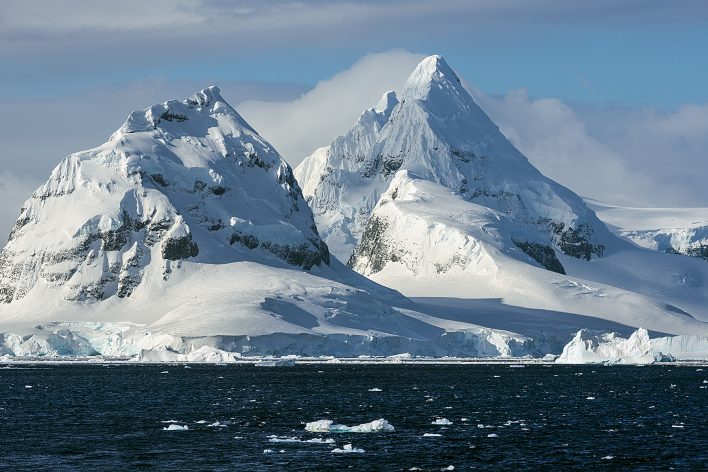
West Virginia University recruited Stoup, and he went on to be an All-American defenseman. When he wasn’t delivering punishing slide tackles, he was a commercial model in New York City. His agency also had an office in L.A., and after graduation he went west to pursue what would become a few professional soccer opportunities, one of which was on a team financed by Rod Stewart. While his teammates made ends meet doing blue collar gigs during the day, plumbing, carpentry and the like, Stoup fell back on modeling and, increasingly, commercial acting.
“The [FIFA Soccer] World Cup was coming around in 1994,” he recalled. “I was in L.A. Starting in ’92, all the companies, whether it’s Mastercard or Snickers or whatever brand you had, they wanted to do a soccer commercial. Back then you got residuals. If it was prime time or a Super Bowl commercial, you got a big payday. It allowed me to be able to travel and to have that freedom where I wasn’t worried about that financial burden. I could really do whatever the fuck I wanted.”
Increasingly that included snowboarding all over the planet: Rainier, Denali, the Grand Teton, Choy Oyo. “I’m not really into the Seven Summits, but I like climbing big mountains and doing stuff,” Stoup told me. Stuff meaning, slide on down after. So, soon after Doug and Emily Coombs pioneered Valdez Heli Guides in Alaska, Stoup would spend some of his residuals and join them for a month each spring at a time when none of his young friends had the time or money for such extravagances. The guides called him Malibu Doug after his handle on an American Gladiators-inspired wrestling show—which he won.
He’d later parlay his growing notoriety into a role on Bay Watch in the pre-Pamela Anderson days. And more checks rolled in. He started to work as a trainer for movie casts, including Sylvester Stallone’s Cliffhanger, where he also worked as an aerial rigger. Jamie Lee Curtis hired him to train her for her role in True Lies. But there was something missing in Hollywood. And Malibu Doug wasn’t really who he wanted to be on screen or off.
“I got bored with training people,” he remembered. “I’d want to go away on vacation and go snowboarding or skiing, and my clients would be like, ‘What am I going to do for two weeks while you’re away?’ I knew that I wanted something else.”
And he wanted to be somewhere else, too. Thanks to the mentorship of Coombs and others, in 1999 he coordinated a ski and snowboard expedition to Mount Vinson, Antarctica’s highest peak, with an A-list team of pro skiers and snowboarders, including Coombs, Dirk Collins, Stephen Koch, photographer Wade McKoy and Mark Newcomb. Looks and money can open a lot of doors, the rest is showing up. As for showing up, the Ice Axe Expeditions trip we’re on today is his 39th trip to Antarctica, and he’s done a further 17 trips to the North Pole. Wally Herbert would be impressed.
Malibu to Iceman
“I definitely had a motor when I was younger,” Stoup told me in Ushuaia. “I remember in college we’d do these 9-mile runs before practice would even start, and I’d be a quarter mile in front of everybody.”
That drive, which Stoup noticed in himself at a young age, clearly attracted the attention of others, Coombs included. “He wanted to make sure I had the necessary skills to go on an expedition with him,” Stoup recalled. “I had the most amazing mentorship.
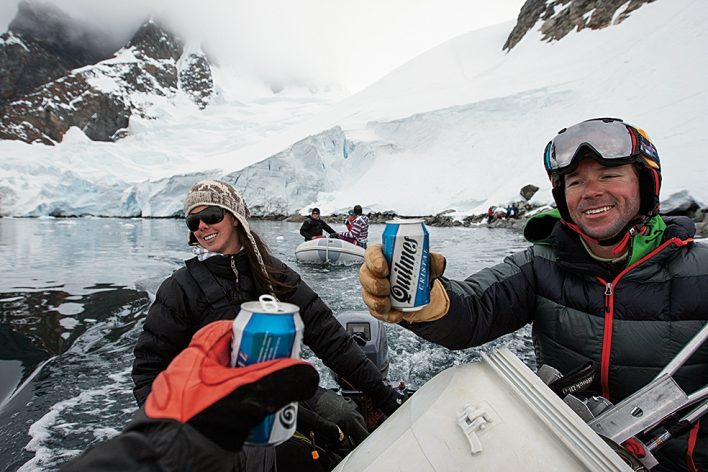
“After I’d spend a month in Alaska, I’d go to Chamonix. And that’s where I’d really learn my skills. And I was always hiring guides and became friends with a lot of people. I saw what could be done.”
So, Stoup had a God-given motor and natural drive. By the time he was in his mid-30s, the money and the time was there. It all came together in the late ’90s, when Stoup had amassed the experience to take on bigger and bigger objectives. He was recognizing that the pursuit of all these things could allow him to transition away from L.A. and into the mountains full time. So, he moved to Tahoe in 2000 and figured he could adventure and get paid for it.
The hook was set. Two months after his successful trip to Vinson, Stoup reached out to a contact on a Russian research vessel and asked if he and a small team could come aboard. This time he’d forgo the mainland for the peninsula, which is known for warmer temperatures, mountains up to 9,000 feet right from the ocean, thousands of unskied lines and a longer season for the kind of “expedition” he’d envisioned.
“We went to the Antarctic Peninsula to pioneer skiing down there. We skied some amazing stuff,” Stoup would later tell a rapt audience in the observation room on the Ocean Albatross during a slideshow. “This is a run called Ice Princess. We had to wait a couple hours for it to be skiable. We did the first descent of Mount Scott. We came through the Lamare Channel near Wiencke Island.”
Six months after pioneering the Antarctic Peninsula for skiing in 2000, Stoup was asked to guide Miles Barber, who is blind, and John Cook, who is deaf, from the coast to the South Pole. “I had never done anything like this before,” he said during his slideshow. “So, it was quite an adventure, and I was trying to figure out how I was going to do it, let alone how I was going to get a blind guy and a deaf guy across Antarctica.”
Initially, Stoup thought if he could rig a bell to his sled that would be enough to keep Barber on the right track. “Five minutes into the expedition I look back and Miles is walking off into the abyss,” he recalls. “I realized that wasn’t going to work. So, I ended up just standing right next to him for 62 days and 787 miles pinching him with my mitten. I would push him and pull him around the sastrugi to make sure he didn’t trip.” Stoup would become the first American to ski from the coast to the pole.
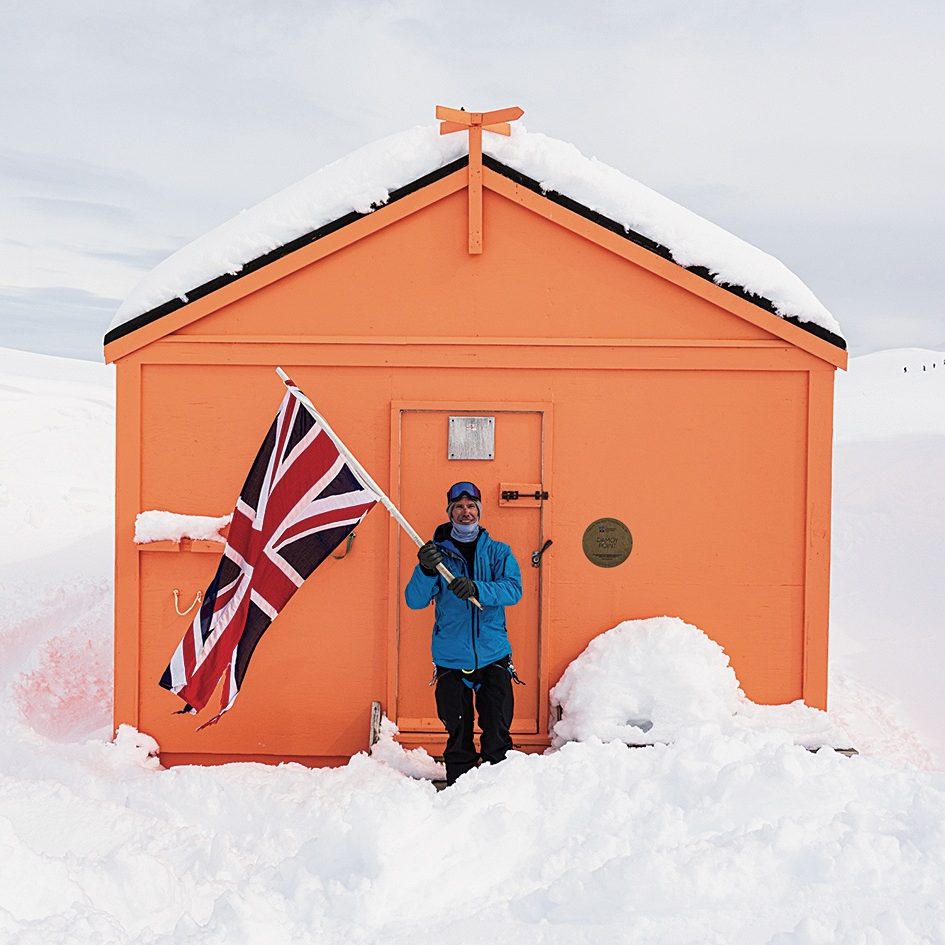
Regardless of his client’s personal objective when it comes to Stoup’s truly polar expeditions, he requires them to raise money for some sort of charity. In the case of Barber and Cook, it was for the Royal National Institute for the Blind. Over the course of his nearly two dozen expeditions, he’s helped his clients raise millions of dollars.
As Stoup was mentored by the likes of Coombs and Koch, he himself works with a lot of young people to help them either follow in his footsteps or pursue objectives wildly dissimilar than his own. On this trip alone there are several protégés, one of whom has never skinned before. I think Stoup uses his trips as a way to show young people that nothing is beyond their reach.
As Stoup recounts just a handful of his exploits, crevasse falls, snow blindness, dozens of polar bear encounters, it starts to become a little clearer to me why we’re here. As he’ll be the first to tell you, it’s not about the money. And it’s not about seconds either. Without exception, every one of Stoup’s polar missions, whether he’s guiding a client or two, he’s doing something unique. That is, of course, with the exception of this ski cruise, which he’s led 14 times since 2009. For him, not us, this is Antarctica light. The White Continent without the frostbite. A polar experience with a sauna onboard where you can watch icebergs floating past as you sip a cold beer.
“This trip, you’re just never going to forget it,” McLean says. “You’ll forget the skiing, eventually. But you just don’t forget the experience of being on the ship, going where we were, seeing the storms and seeing the intensity of the environment, crossing the Drake. It’s just an incredibly unique and powerful trip. In the end it’s not really a secret. Just, nobody [but Stoup] has the guts.” The guts to believe that the best guides in the world, teamed with a maturing maritime tourism industry, can land 100-plus skiers here for a week.
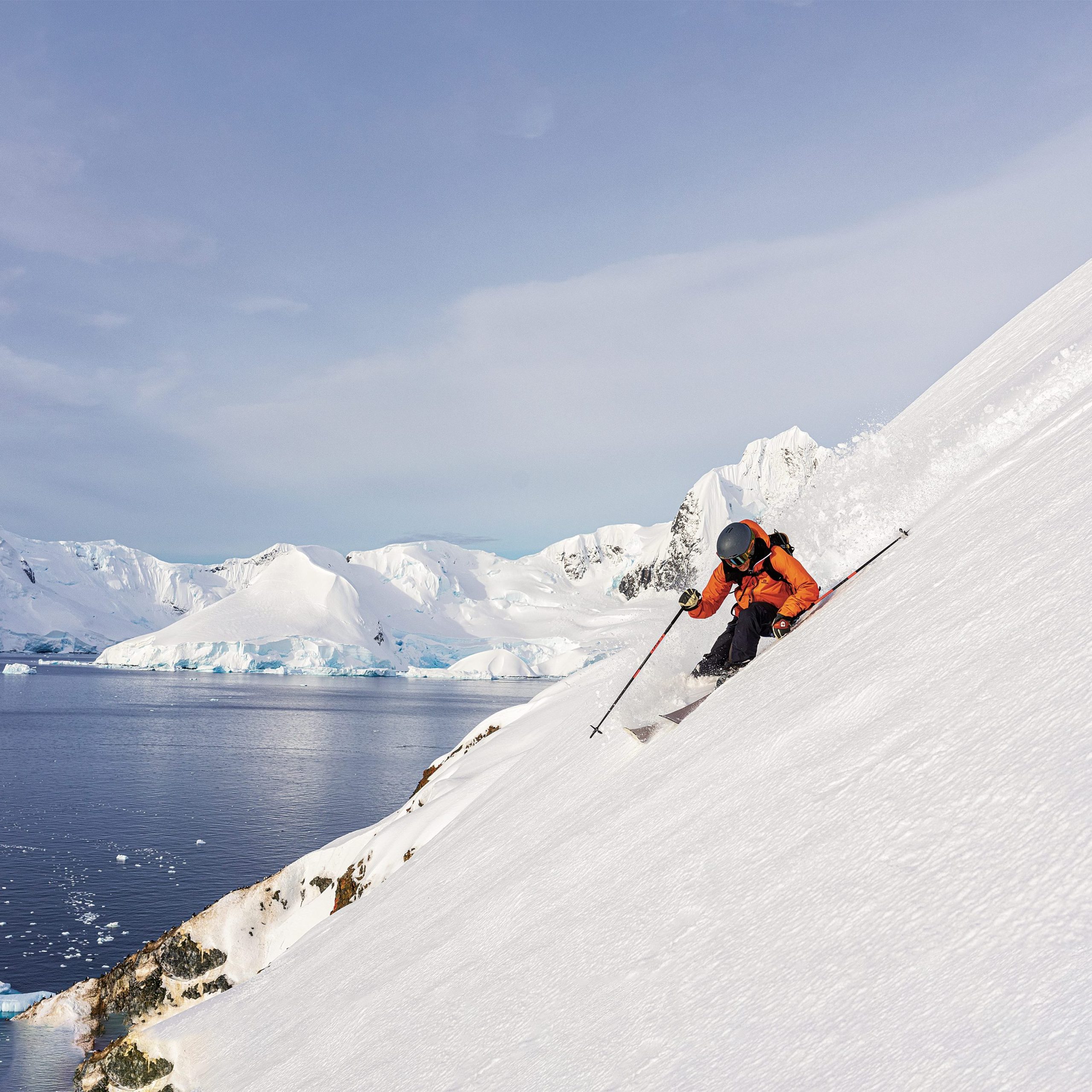
But, how sustainable is this sort of Antarctic tourism, with or without skiing? Without an official government it’s hard to say. Certainly, all we’re leaving is tracks. Our boots get washed each time we get back on the boat to prevent the spread of bird flu. Packs aren’t allowed to be set on the snow. No eating on the landings. No pooping or peeing. Any tour operator running boats down here adheres strictly to these guidelines set forth by the International Association of Antarctic Tour Operators (IAATO).
Well north of 70,000 people come to the White Continent each year. Many of those tourists never leave their ship. And if a ship has more than 500 occupants, they’re not allowed to land any of them. As for smaller ships like the Ocean Albatross, most of the regular guests go ashore if only for an hour or two or on a Zodiac tour or a paddleboarding excursion (the thought of which scares the hell out of me). Only the Ice Axe clients stay out all day.
Future of Ice
There is a Pleistocene power to this trip. After all, we’re skiing on 10,000- to 2-million-year-old glaciers dating back to this period. Antarctic ice, while retreating like the rest of the world’s glaciers, is hanging on better than the sheets on the other continents. And, even though Damian, Pat, John and myself know this glacier is still shrinking, it feels like we’re skiing in an age, not unlike the Pleistocene, before climate change as we know and understand it today started to diminish our traditional touring opportunities in North America and Europe.
It’s easy to not think about global warming on a powder day in Antarctica or how we’re contributing to it by traveling all this way to get here. The whole trip has felt like full on winter, not the spring as I anticipated. And it is earlier in the season than Stoup typically comes here. We are, after all, the first commercial ship to the peninsula this season. Still, there’s a common refrain among some of the guests that there’s a little guilt around being in such an untouched place and, as is the case today, tracking the hell out of it. But why?
“I’ve been averse pretty much to the whole mechanized skiing industry,” longtime Ice Axe guide and Winter Wildlands Association ambassador Glen Poulsen later tells me on the deck of the Ocean Albatross. “I started as a Nordic skier and I started ski touring at 10, 11, 12 years old. I’ve been focused on human powered and low impact skiing the whole time.”
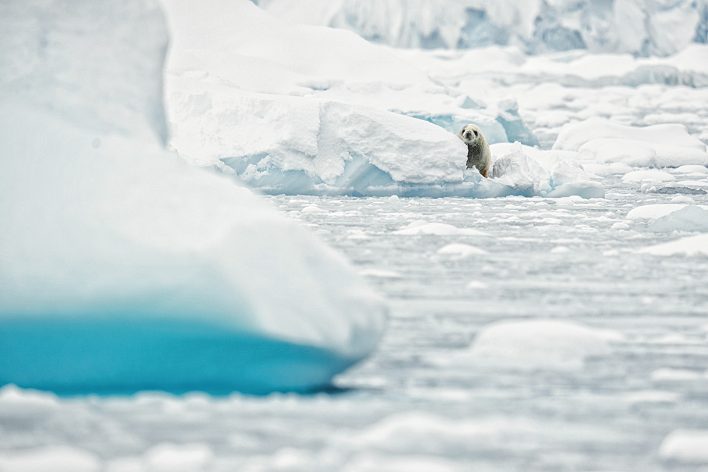
Poulsen has been guiding for Stoup since 2004 and goes on to lament that this trip can be difficult to fill. After crossing the Drake and buzzing around on Zodiacs in pack ice with high winds and zero visibility, I think I understand why. It’s not the difficulty of the skiing: All ascents are roped up, and the descents are mostly low-angle affairs.
“We’ve got to keep the risk level low on this trip,” Poulsen says. “Because of the implications of any sort of rescue, you’ve gotta throttle it back. From a guiding perspective it’s the most complex trip in the world as far as I know, from having to put 100 skiers on snow at once and the interface with the maritime. When you’re up on a ski run having to think about what the wave heights are going to be and what those implications and changes are going to have on the Zodiac operations.”
And, spendy as the trip is, plenty of people heli-ski in Canada or Alaska for pretty much the same scratch. So, I don’t think trepidation is about cost either. No, it’s everything else: two days of travel to get to Ushuaia. Two days on the fabled and frightening Drake Passage. The Drake Shake has claimed some 800 vessels since the first successful passage around Cape Horn in 1616 by the Dutch ship Eendract, skippered by Willem Schouten. Dishes crashing in the kitchen and whizzing across the table into your best mate’s lap. Many guests, like Damian, dope up on Dramamine to cope with the sea sickness the rest of us either suffer through or don’t. Six to seven days on a small ship in foreboding waters with very little chance of immediate rescue and strangers all about can be unsettling for some. But, for me, that’s all the good stuff. So, yeah, part of it is 10-plus days on the “maritime” that intimidate the uninitiated. And those fears are well documented and well founded.
“The first year we came down here we thought Doug was crazy,” Poulsen goes on. “We thought it would be a one-off. But I think it’s on par with any trip you can do in the world as far as the amazing combination of natural history and place and all of it. It’s amazing. You’re not going to get the ski quality you’re going to get on a heli trip in Canada, but the comradery on the ship is amazing.
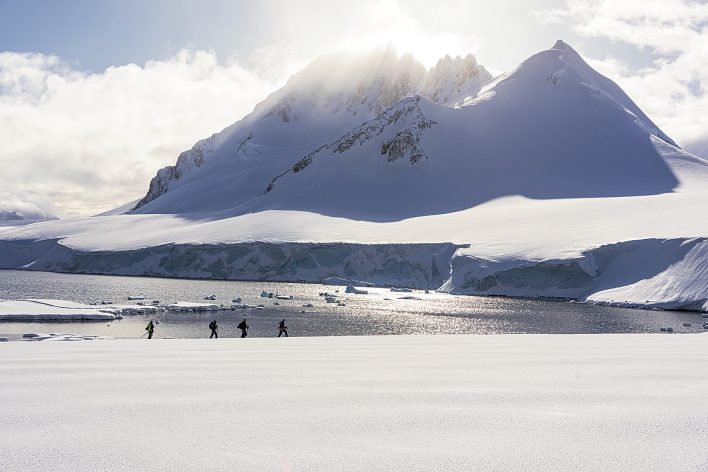
“For us guides it’s really special,” Poulsen adds. “A lot of the guides and a lot of these clients become lifelong friends.” They’ll end up guiding on different trips throughout the year or picking up new clients, as most of the guides have unique tenures from New Zealand to Morocco, Gulmarg to Svalbard, Alaska to Chile.
Don’t forget the Penguins
Since we were the first team out this morning, it’s only courteous that we should be one of the first teams back. So, we forgo another pow run in the bowl below Alex Lowe Couloir to pretty much flat track it back toward the toe of the glacier where we meadow skipped earlier. As we round the escarpment bisecting the terrain we skied all morning, we traverse below Jabet’s south face. It’s been utterly farmed out by the other parties, particularly those with less experienced skiers.
By the time we get to the little ramp to the water we skied six hours ago, the snow has settled out and warmed up. It’s still skiable, but no longer powder.
“Holy shit! Look down there,” Pat points with his pole toward our morning’s landing zone at the gentoo rookery. “Oh, my God,” I burble. While we were away several thousand mating pairs of gentoos arrived for the laying season. They could have come back any other day, but they chose our day. Our powder day. Our powder penguin day.
We stop near a pink quonset hut that’s probably 12 feet wide and 24 feet long. A plaque says “Damoy Point 64°49’S 63°31’W Protected Under the Antarctic Treaty System and Cared for by the United Kingdom Antarctic Heritage Trust.” Inside is a time capsule from when it was built in 1975 for the purpose of staging materials transferred from a ship—anchored about where ours is—and up to a skiway on the glacier. This enabled goods to be flown to the British Antarctic Survey’s bases on the south end of the peninsula when ice prevented ships from getting there. Direct flights to Marguerite Bay from the Falkland Islands started in 1995 and the hut was abandoned.
We skin back up and walk the several hundred yards to the rookery, which is covered in the newly fallen snow we skied today. Sun has opened up some of the terrain to the rock bed on which the penguins will later laze. But today, there are little trenches all about, and the birds are busy establishing what will be their nests once the snow recedes and the humans leave. We’re not predators, so they pay us no mind. On land they wobble and, of course, they can’t fly. But when they get into the water near where the Zodiacs are coming and going, they’re the most athletic animals I’ve ever seen. It’s like they’re propelled by electric screws, and when they want back on shore it’s with a gymnastic thrust out of the water and a two-footed touchdown like they’re coming off the high bars.

To ski powder all day above the South Sea with your best friends and descend into a world you’d never expect filled with thousands of penguins. This is why we’re here. No, it’s not about the skiing, though contrary to what McLean says, I will remember today’s turns. It’s about the wildlife and the glaciers, the history and the relative ease with which we get from anchorage to anchorage. It literally is the trip of a lifetime, a term I’ve never used before because, until today, I never thought the last trip would be the best. Is this why Stoup brings us here? Is this why his life is so filled with so many firsts?
That plays a little bit into what Stoup told me in Ushuaia: “I don’t do this for the money,” he said in the hotel lobby as his guests loaded into buses upstairs. I mentioned this conversation to Rich Meyer, another well-known California guide who’s been on this trip many times. And he said, yeah, maybe there’s some ego involved, sure. Show me a famous adventurer without one.
“We may be perverted representatives for what’s best for the Antarctic,” Meyers will later tell me at Stoup’s famous White Party, where guides and guests rage onboard the last night before port. “But we are representatives, and so few people get here. Why isn’t it helpful to have us be the representative body?”
Why not indeed. As for Stoup and his motivation for, as Poulsen says, “audacity,” maybe if you can do something you should. And when it comes to taking thousands of skiers to experience the wildest place on earth, only one man, the enigma that is Douglas Malibu Iceman Stoup, can possibly dream that big. And, so he does.
This article was originally published in The Historic Issue. To read the full story, grab a copy, or subscribe to read our stories when they’re first published.










Related posts: